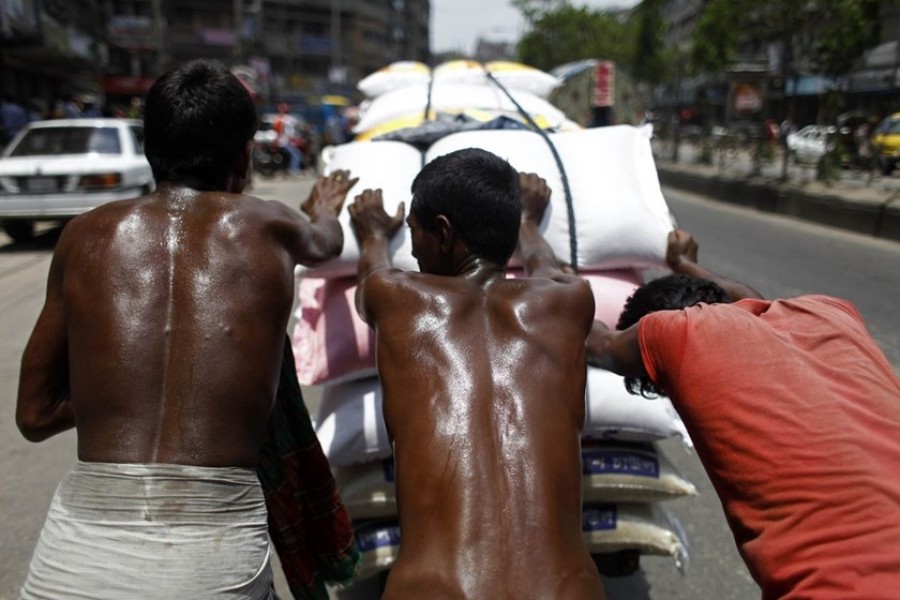Low levels of labour productivity have always remained a cause for concern in this part of the world. Even South-east Asian nations not so famed for tall and muscular physical build have long accounted for higher performance in the manufacturing and industrial sector. The reason behind this was thought to be those peoples' agility, training, a regime of discipline and their switchover to industrialisation earlier than in countries like Bangladesh. Productivity in Chinese garment factories is much higher than here.
Although a combination of factors has allowed the Chinese entrepreneurs the luxury of jettisoning some of their labour-intensive RMG ventures in favour of more paying precision manufacturing enterprises, they still retain a near monopoly in the high-end apparel production and export. This explains why Chinese RMG workers draw much higher wages than their Bangladesh counterparts.
To make the matter worse, a new study titled "Hot Cities Chilled Economies: Impacts of extreme Heat on Global Cities" finds that higher temperature has a direct adverse effect on labour productivity.
The study, as its title suggests, has concentrated on a number of cities including Dhaka to see how these cities fare in terms of productivity loss on account of higher temperature. A few days ago Dhaka came second in terms of the most polluted city in the world. This time, though, it has topped the list for loss of labour productivity.
What is remarkable here is that temperatures vary within the city and the hotspots register 10 degree Celsius higher temperature than the surrounding countryside. A few pockets surrounded by tall buildings were found to have 12 degree higher temperature. With corrugated iron sheets serving as roof, the shabby accommodations for manufacture of an array of products are a veritable hell.
What makes the situation nightmarish for workers is the combined impact of heat and humidity with little or no natural system of cooling the surroundings. Pathetically, some of the poorest areas are among the hotspots of heat stress. Those who are directly exposed to heat and burning sun overhead, risk their health at times leading to the death of a few.
In economic terms, the productivity loss is worth as high as $6.0 billion a year. If losses of other cities suffering from excessive heat are taken into account, the figure may be in the double digit. Even countryside, as predicted earlier, were supposed to encounter a phenomenon of wet-bulb temperature under the spell of which people would suffer severe heat stroke causing instant death. This is somewhat like the heat dome over an area ---at times spread over states --- in which heat gets trapped due to high pressure with no escape route. British Columbia of Canada and northern region of the United States of America experienced a deadly heat dome in which more than 800 people on both sides of the border lost lives.
So the economic loss of Dhaka City will not tell the full story of the productivity loss this nation is likely to suffer in the days to come. Surely, the issue is interlinked with global warming but as long as the nations collectively fail to go for drastic and pragmatic measures to curb temperature rise, should countries like Bangladesh consider that it is fated to suffer the worst consequences of climate change? True, a comprehensive solution to this problem is beyond any nation's capacity let alone that of a country like Bangladesh. But local measures can be of some help in stalling or improving the adverse impacts.
So far as Dhaka City's hotspots and the overall temperature are concerned, management of those is quite possible if not immediately at least within a reasonable time frame. Planting trees in every vacant space of this city can do the trick. Those who frequent the road running between the quarters of ministers and the Ramna Park are not likely to miss the soothing and several degree cooler temperature there. The difference is felt as soon as one enters the area boasting green covers all around.
Accepted that such green covers cannot be built all over the city but many of its avenues can have long lines of local trees that barely shed their leaves all at once. The concrete jungle that the capital city has turned into because of a lack of planned development and foresight is exacting a price in terms of health, longevity and economy. The situation cannot be reversed but if the citizens are serious and the policymakers take the right initiatives, together they can bring about a discernible change in the situation.
That the mayor of Dhaka North City Corporation (DNCC), during recovery of the Lautola canal, personally supervised the demolition of constructions within 20 feet on both sides of its bank is the kind of initiative and seriousness required for building up a green cover for Dhaka.
If all the water bodies, including canals and rivers, running through or by the city proper can be restored to their optimum water flows and trees planted on their banks, Dhaka will definitely become much cooler. Green factories are the other option to complement the initiative.


